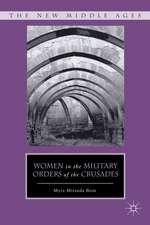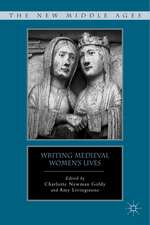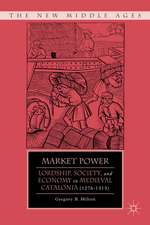Magnificence and the Sublime in Medieval Aesthetics: Art, Architecture, Literature, Music: The New Middle Ages
Editat de S. Jaegeren Limba Engleză Hardback – 17 noi 2010
Din seria The New Middle Ages
- 20%
 Preț: 690.01 lei
Preț: 690.01 lei - 17%
 Preț: 457.58 lei
Preț: 457.58 lei - 20%
 Preț: 629.01 lei
Preț: 629.01 lei - 18%
 Preț: 782.42 lei
Preț: 782.42 lei - 15%
 Preț: 636.80 lei
Preț: 636.80 lei - 8%
 Preț: 537.27 lei
Preț: 537.27 lei - 20%
 Preț: 566.94 lei
Preț: 566.94 lei - 9%
 Preț: 626.77 lei
Preț: 626.77 lei - 20%
 Preț: 629.10 lei
Preț: 629.10 lei -
 Preț: 347.97 lei
Preț: 347.97 lei - 8%
 Preț: 563.62 lei
Preț: 563.62 lei - 9%
 Preț: 626.68 lei
Preț: 626.68 lei - 15%
 Preț: 524.70 lei
Preț: 524.70 lei - 8%
 Preț: 459.88 lei
Preț: 459.88 lei -
 Preț: 303.51 lei
Preț: 303.51 lei -
 Preț: 389.70 lei
Preț: 389.70 lei -
 Preț: 390.63 lei
Preț: 390.63 lei -
 Preț: 383.93 lei
Preț: 383.93 lei -
 Preț: 385.62 lei
Preț: 385.62 lei -
 Preț: 390.25 lei
Preț: 390.25 lei -
 Preț: 385.25 lei
Preț: 385.25 lei - 5%
 Preț: 712.81 lei
Preț: 712.81 lei - 15%
 Preț: 640.06 lei
Preț: 640.06 lei -
 Preț: 398.15 lei
Preț: 398.15 lei -
 Preț: 393.35 lei
Preț: 393.35 lei - 18%
 Preț: 725.13 lei
Preț: 725.13 lei - 18%
 Preț: 724.17 lei
Preț: 724.17 lei -
 Preț: 388.90 lei
Preț: 388.90 lei - 15%
 Preț: 698.30 lei
Preț: 698.30 lei -
 Preț: 386.39 lei
Preț: 386.39 lei -
 Preț: 387.38 lei
Preț: 387.38 lei -
 Preț: 384.48 lei
Preț: 384.48 lei - 18%
 Preț: 726.69 lei
Preț: 726.69 lei -
 Preț: 385.08 lei
Preț: 385.08 lei - 15%
 Preț: 639.14 lei
Preț: 639.14 lei -
 Preț: 388.72 lei
Preț: 388.72 lei -
 Preț: 389.11 lei
Preț: 389.11 lei -
 Preț: 387.20 lei
Preț: 387.20 lei - 15%
 Preț: 697.97 lei
Preț: 697.97 lei - 15%
 Preț: 640.24 lei
Preț: 640.24 lei - 15%
 Preț: 499.92 lei
Preț: 499.92 lei -
 Preț: 388.72 lei
Preț: 388.72 lei -
 Preț: 387.96 lei
Preț: 387.96 lei - 15%
 Preț: 579.20 lei
Preț: 579.20 lei -
 Preț: 391.40 lei
Preț: 391.40 lei - 15%
 Preț: 640.37 lei
Preț: 640.37 lei - 15%
 Preț: 641.71 lei
Preț: 641.71 lei -
 Preț: 384.70 lei
Preț: 384.70 lei
Preț: 727.97 lei
Preț vechi: 887.76 lei
-18% Nou
Puncte Express: 1092
Preț estimativ în valută:
139.32€ • 144.91$ • 115.01£
139.32€ • 144.91$ • 115.01£
Carte tipărită la comandă
Livrare economică 14-28 aprilie
Preluare comenzi: 021 569.72.76
Specificații
ISBN-13: 9780230618985
ISBN-10: 0230618987
Pagini: 274
Ilustrații: XI, 309 p.
Dimensiuni: 140 x 216 x 20 mm
Greutate: 0.45 kg
Ediția:2010
Editura: Palgrave Macmillan US
Colecția Palgrave Macmillan
Seria The New Middle Ages
Locul publicării:New York, United States
ISBN-10: 0230618987
Pagini: 274
Ilustrații: XI, 309 p.
Dimensiuni: 140 x 216 x 20 mm
Greutate: 0.45 kg
Ediția:2010
Editura: Palgrave Macmillan US
Colecția Palgrave Macmillan
Seria The New Middle Ages
Locul publicării:New York, United States
Cuprins
Introduction; C.S.Jaeger 'Opus es magnificum': The Image of God and the Aesthetics of Grace; M.Rossi Monti Singers and the Grandeur of Worship in the West, 400-800; C.Page 'Incessu humilem, successu excelsam': Augustine, Sermo humilis and Scriptural; D.Shanzer Magnificence in Miniature: The Case of Early Medieval Manuscripts; A.Cohen Cantor's King: The Magnification of Robert II; M.Fassler Reflections on the Wonderful Height and Size of Gothic Great Churches; P.Binski Richard of St. Victor and the Medieval Sublime; C.S.Jaeger 'Error Left Me and Fear Came in its Place': Giants and the Sublime in Dante and Medieval Literature; E.Stoppino The Magnificent Builder in Late Medieval Italy; A.Marina Sound and the City: Listening to Magnificence in Medieval Paris; E.Dillon How Magnificent was Medieval Art?; B.Williamson
Recenzii
'It is a brilliant collection of essays unpacking medieval art in a new, and to most of us I suspect, unfamiliar way. If you love aesthetics, medieval art of any kind, or just wish to broaden your perception of the culture of medieval Europe, this is a wonderful scholarly excursion.' The Journal of the Association of Anglican Musicians
"'The church of Notre-Dame is no doubt still a sublime and majestic edifice . . . a sort of human creation, mighty and fertile as the divine creation . . .which to use the language of the chroniclers 'by its vastness struck terror into the spectator.' When Victor Hugo opened the influential Book XIV of his "Hunchback" with this characterization, he was recapitulating and advancing a concept of the medieval achievement that, in recent years, has ceded almost completely to what Stephen Jaeger terms the "Diminutive Middle Ages." Magnificence and the Sublime: The Aesthetics of Grandeur in the Middle Ages: Art, Architecture, Music and Literarture sets out to return interest in the lofty, spiritual, and even terrifying in medieval culture from the current preoccupation with the humble and carnal; and it succeeds masterfully by shifting focus from the marginal to the unbounded, from imitation to astonishment, from visuality to visionary. Thus, Caroline Bynum's "Wonder" and Julia Kristeva's Power of Horror replace Eric Auerbach's Literary Language and its Public in Late Antiquity and the Middle Ages as guiding texts for its revisionist agenda; and, while Jeffrey Hamburger is frequently cited, Michael Camille and David Freedberg are not mentioned. Knitted together by Stephen Jaeger's own fine Introduction, the eleven essays engage the subject from diverse perspectives - etymology and rhetoric, music and urban hubbub, architecture and patronage; and they demonstrate the fact that, even without access to (Pseud-) Longinus' On the Sublime, the arts of the Middle Ages were composed to amaze as well as teach and to transport the soul as much as persuade the mind. Enlarging (and, in so doing, largely destroying) the dominant paradigm underlying Auerbach's notion of anagogy as a humble mask for divine mysteries, the diverse contributions examine the many radical strategies writers, composers, architects, theologians, and manuscript illuminators deployed to shatter any sense of rational bridging. These included, among other devices, textual tessellation, material varietas, heroic size, scale, and accumulation, cacophony, public display of largess, and overwhelming imaginings.The sum total is the most important book on medieval aesthetics that has appeared in several generations. Itself mighty and fertile, Magnificence and the Sublime in Medieval Aesthetics is a colossal edifice that provides the reader with a new perspective, one that, like the dazzling view Hugo's breathless spectator sees from the summit of Notre Dame, is astoundingly different from what she or he has heretofore been able to apprehend from the ground." - Herbert L. Kessler, Professor of the History of Art, Johns Hopkins University
"On entering a cathedral, I am filled with devotion and with awe," wrote Coleridge: "I am lost to the actualities that surround me, and my whole being expands into the infinite; earth and air, nature and art, all swell up into eternity." Coleridge knew that the Middle Ages could indeed produce sublime and magnificent works of art. Modern criticism, instead, has tended to ignore these categories, arguing that there is very little medieval discussion of the terms, and of the concepts they imply. Here finally is a well-organized, comprehensive book that makes the case for sublimity and magnificence in medieval aesthetic thought: in theology, philosophy, biblical exegesis, singing, miniature, architecture. The three heroes of this "rebirth of the sublime" in medieval studies are Augustine, Richard of St Victor, and Dante. But readers will also be surprised to encounter an "aesthetics of grace" and the "grandeur of worship", as well as to discover why medieval aristocrats and prelates insisted on building such "magnificent" castles, palaces, and churches. After reading this book, they will be able to enter those buildings, listen to medieval music, and read books like Dante's Comedy with a new awareness - one akin to Coleridge's feelings." - Piero Boitani, FBA, Professor of Comparative Literature, University of Rome "Sapienza," author of The Tragic and the Sublime in Medieval Literature.
"Magnificence and the Sublime is a welcome addition to The New Middle Ages series, and a significant contribution to interdisciplinary scholarship on medieval aesthetics. This is a book that breaks important new ground. Each of its essays makes an original contribution to the field of Medieval Studies, and each also provides scope for future research." - The Medieval Review
"'The church of Notre-Dame is no doubt still a sublime and majestic edifice . . . a sort of human creation, mighty and fertile as the divine creation . . .which to use the language of the chroniclers 'by its vastness struck terror into the spectator.' When Victor Hugo opened the influential Book XIV of his "Hunchback" with this characterization, he was recapitulating and advancing a concept of the medieval achievement that, in recent years, has ceded almost completely to what Stephen Jaeger terms the "Diminutive Middle Ages." Magnificence and the Sublime: The Aesthetics of Grandeur in the Middle Ages: Art, Architecture, Music and Literarture sets out to return interest in the lofty, spiritual, and even terrifying in medieval culture from the current preoccupation with the humble and carnal; and it succeeds masterfully by shifting focus from the marginal to the unbounded, from imitation to astonishment, from visuality to visionary. Thus, Caroline Bynum's "Wonder" and Julia Kristeva's Power of Horror replace Eric Auerbach's Literary Language and its Public in Late Antiquity and the Middle Ages as guiding texts for its revisionist agenda; and, while Jeffrey Hamburger is frequently cited, Michael Camille and David Freedberg are not mentioned. Knitted together by Stephen Jaeger's own fine Introduction, the eleven essays engage the subject from diverse perspectives - etymology and rhetoric, music and urban hubbub, architecture and patronage; and they demonstrate the fact that, even without access to (Pseud-) Longinus' On the Sublime, the arts of the Middle Ages were composed to amaze as well as teach and to transport the soul as much as persuade the mind. Enlarging (and, in so doing, largely destroying) the dominant paradigm underlying Auerbach's notion of anagogy as a humble mask for divine mysteries, the diverse contributions examine the many radical strategies writers, composers, architects, theologians, and manuscript illuminators deployed to shatter any sense of rational bridging. These included, among other devices, textual tessellation, material varietas, heroic size, scale, and accumulation, cacophony, public display of largess, and overwhelming imaginings.The sum total is the most important book on medieval aesthetics that has appeared in several generations. Itself mighty and fertile, Magnificence and the Sublime in Medieval Aesthetics is a colossal edifice that provides the reader with a new perspective, one that, like the dazzling view Hugo's breathless spectator sees from the summit of Notre Dame, is astoundingly different from what she or he has heretofore been able to apprehend from the ground." - Herbert L. Kessler, Professor of the History of Art, Johns Hopkins University
"On entering a cathedral, I am filled with devotion and with awe," wrote Coleridge: "I am lost to the actualities that surround me, and my whole being expands into the infinite; earth and air, nature and art, all swell up into eternity." Coleridge knew that the Middle Ages could indeed produce sublime and magnificent works of art. Modern criticism, instead, has tended to ignore these categories, arguing that there is very little medieval discussion of the terms, and of the concepts they imply. Here finally is a well-organized, comprehensive book that makes the case for sublimity and magnificence in medieval aesthetic thought: in theology, philosophy, biblical exegesis, singing, miniature, architecture. The three heroes of this "rebirth of the sublime" in medieval studies are Augustine, Richard of St Victor, and Dante. But readers will also be surprised to encounter an "aesthetics of grace" and the "grandeur of worship", as well as to discover why medieval aristocrats and prelates insisted on building such "magnificent" castles, palaces, and churches. After reading this book, they will be able to enter those buildings, listen to medieval music, and read books like Dante's Comedy with a new awareness - one akin to Coleridge's feelings." - Piero Boitani, FBA, Professor of Comparative Literature, University of Rome "Sapienza," author of The Tragic and the Sublime in Medieval Literature.
"Magnificence and the Sublime is a welcome addition to The New Middle Ages series, and a significant contribution to interdisciplinary scholarship on medieval aesthetics. This is a book that breaks important new ground. Each of its essays makes an original contribution to the field of Medieval Studies, and each also provides scope for future research." - The Medieval Review
Notă biografică
C. STEPHEN JAEGER is Professor Emeritus in the Departments of Germanic Language and Literature at the University of Illinois, USA.















